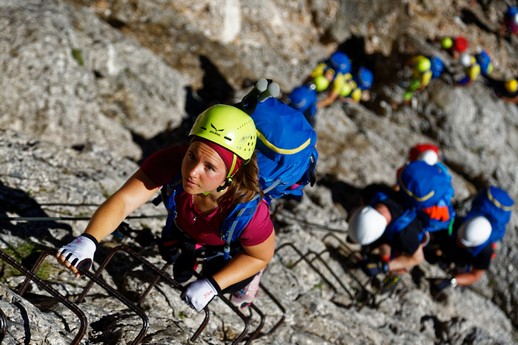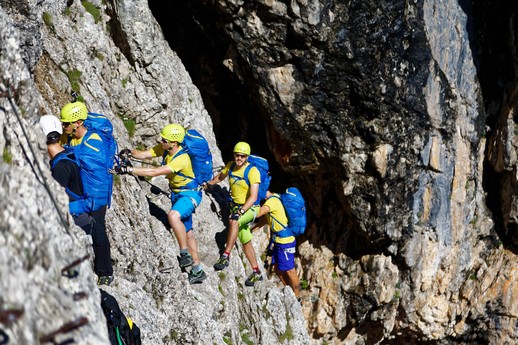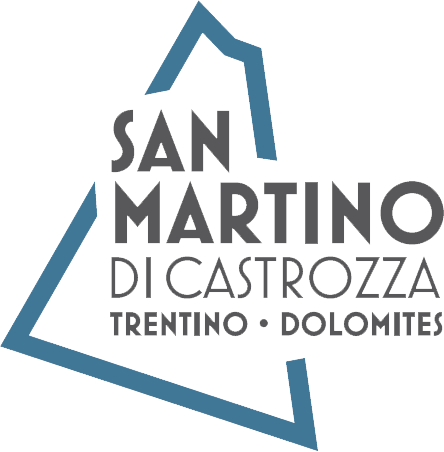Via Ferratas

Via ferratas climb up veritable rock faces and are totally or partially equipped with fixed steel-wire ropes, rungs or ladders. To tackle them safely one should be fit, have mountain experience, have no fear of heights and a grasp of basic climbing techniques.
Ferratas should never be underestimated and must be tackled with the correct equipment and clothes (mountain shoes and clothes, helmet, harness and via ferrata set with shock absorber).
If you do not have any climbing or mountain experience, we recommend that you contact the Alpine Guides in San Martino.
CLICK HERE AND WATCH THE VIDEO TUTORIALS TO PREPARE FOR THE VIA FERRATAS
Short introduction for beginners about the main features of the vie ferrate in the unique environment of the Altopiano delle Pale di San Martino.
SECOND EPISODE:
Getting ready for a via ferrata: collecting information, checking the equipment and kit and getting ready to do it in safe conditions.
THIRD EPISODE:
Let’s start the ferrata: information about how to wear the via ferrata kit in the right way and in order to be safe.
FOURTH EPISODE:
The main suggestions to minimize the risks on equipped paths and to learn how to behave in case of difficult situations.
FIFTH EPISODE:
The secrets of the job shared by the alpine guide.
.jpg)
The starting point is only 5 minutes from the Canali/Treviso mountain hut. It is a short, vertical and fun ferrata, part of a 2-hour ring-route with a first stretch of equipped ferrata leading to the Forcella delle Mughe from which a path descends back down to the mountain hut.
Ferrata Fiamme Gialle
The actual ferrata can be considered of medium to medium-high difficulty. The considerable length of the whole trail and noteworthy gain in height certainly make the "via delle Fiamme Gialle" a hard itinerary, not to be underestimated, especially if one wants to ascend to the Croda Granda peak. Be very careful if you choose to descend via the Vani Alti path. This is in fact, as mentioned above, an alpine itinerary that must be tackled with due caution and the appropriate equipment. If you are not sufficiently familiar with the basics of mountain climbing, it is preferable to descend via the Scalette path, even if it is a long and exhausting trail.
Ferrata Bolver-Lugli to Cimon della Pala
Very hard ferrata, for expert climbers only. About one hour from Colverde (2000 m), a bronze plaque at the base of the rock-face points to the starting point of the ferrata.
Follow the red marks and climb up easy stretches of rock to the first ropes and rungs of the ferrata at 2500 m altitude. Here the route becomes steep and quite exposed.
On climbing out of a demanding vertical chimney, the ferrata continues over a ridge and reaches a large detrital hollow where it then continues to the Fiamme Gialle bivouac hut (3005 m). Total time about 3.30 hours.
Ferrata del Velo
A hard itinerary, that takes about 3 hours and connects Rifugio Pradidali to Rifugio del Velo through Forcella del Portòn; one of the most "classical" ferratas in the Dolomites, it has quite a few exposed stretches equipped with iron rungs.
Sentiero attrezzato “Dino Buzzati”
Equipped in 1977 as a homage to the famous writer that climbed in Val Canali for years, the trail crosses the Cimerlo Massif on a mostly downhill itinerary starting at the Velo mountain hut and ending at the Cant del Gal Hotel (4 hours).
Sentiero attrezzato “Nico Gusella”
This very hard itinerary starts at Passo di Ball (reached from Rifugio Rosetta or Rifugio Pradidali) and leads to Rifugio del Velo. A short detour along the route leads to the top of Cima Val di Roda, offering an outstanding view over the entire valley.
Sentiero attrezzato “Camillo Depaoli”
Dedicated to a local Alpine guide who was very active in the Sixties and Seventies, this easy itinerary climbs from the Fosne meadows in Val Canali (1350 m) to Rifugio Velo (2358 m) along the western slopes of the Cimerlo.
Sentiero attrezzato “Passo di Ball”
Discovered in 1869 by the famous English mountain-climber Leslie Stephen and dedicated (along with the peak above) to his friend John Ball, author of the first Guide to the Dolomites, this path is quite easy and connects the Rosetta and Pradidali mountain huts.
The new Via Ferrata Val di Scala has been inaugurated during the summer 2018 in Vanoi Valley, not far from Caoria Village. The starting point is at 770 m and is equipped with steel cables, steps and small bridges made of wood. Particularly appreciated is the rope bridge and the landscape surrounding the ferrata, made of rocks and wood crossed by water. At the end of the via ferrata (980 m) you will find an easy path that will take you back to valley.
Val di Scala is considered an “educational” via ferrata and is perfect for families and for beginners.










